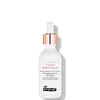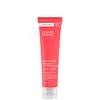What's inside
What's inside
 Key Ingredients
Key Ingredients

 Benefits
Benefits

 Concerns
Concerns

 Ingredients Side-by-side
Ingredients Side-by-side

Water
Skin ConditioningIsododecane
EmollientPolyglyceryl-6 Polyricinoleate
EmulsifyingPropanediol
SolventDimethicone
EmollientCaprylic/Capric Triglyceride
MaskingTrimethylsiloxysilicate
EmollientButyloctyl Salicylate
Skin ConditioningCoco-Caprylate/Caprate
EmollientIsoamyl Laurate
EmollientNeopentyl Glycol Diheptanoate
EmollientPolyglyceryl-10 Dioleate
EmulsifyingLecithin
EmollientPolyhydroxystearic Acid
EmulsifyingEctoin
Skin ConditioningPolymethylsilsesquioxane
Polysilicone-11
Disteardimonium Hectorite
StabilisingButyrospermum Parkii Butter
Skin ConditioningGlycerin
HumectantPhenoxyethanol
PreservativePropylene Carbonate
SolventAminomethyl Propanol
BufferingCitrus Aurantium Dulcis Peel Oil
MaskingEthylhexylglycerin
Skin ConditioningPolysorbate 20
EmulsifyingSclareolide
MaskingTocopheryl Acetate
AntioxidantDimethicone/Vinyl Dimethicone Crosspolymer
Skin ConditioningDimethiconol
EmollientLinalool
PerfumingLinalyl Acetate
MaskingPlankton Extract
Skin ConditioningLavandula Angustifolia Oil
MaskingLavandula Hybrida Oil
EmollientDecyl Glucoside
CleansingSodium Ascorbate
AntioxidantCaprylyl Glycol
EmollientHexylene Glycol
EmulsifyingTocopherol
AntioxidantWater, Isododecane, Polyglyceryl-6 Polyricinoleate, Propanediol, Dimethicone, Caprylic/Capric Triglyceride, Trimethylsiloxysilicate, Butyloctyl Salicylate, Coco-Caprylate/Caprate, Isoamyl Laurate, Neopentyl Glycol Diheptanoate, Polyglyceryl-10 Dioleate, Lecithin, Polyhydroxystearic Acid, Ectoin, Polymethylsilsesquioxane, Polysilicone-11, Disteardimonium Hectorite, Butyrospermum Parkii Butter, Glycerin, Phenoxyethanol, Propylene Carbonate, Aminomethyl Propanol, Citrus Aurantium Dulcis Peel Oil, Ethylhexylglycerin, Polysorbate 20, Sclareolide, Tocopheryl Acetate, Dimethicone/Vinyl Dimethicone Crosspolymer, Dimethiconol, Linalool, Linalyl Acetate, Plankton Extract, Lavandula Angustifolia Oil, Lavandula Hybrida Oil, Decyl Glucoside, Sodium Ascorbate, Caprylyl Glycol, Hexylene Glycol, Tocopherol
Water
Skin ConditioningC12-15 Alkyl Benzoate
AntimicrobialZinc Oxide
Cosmetic ColorantTitanium Dioxide
Cosmetic ColorantGlycerin
HumectantIsononyl Isononanoate
EmollientButylene Glycol
HumectantCetearyl Alcohol
EmollientPotassium Cetyl Phosphate
EmulsifyingDimethicone
EmollientGlyceryl Stearate
EmollientGlycyrrhiza Glabra Root Extract
BleachingActinidia Chinensis Fruit Extract
EmollientArgania Spinosa Kernel Oil
EmollientTetrapeptide-30
Skin ConditioningLinoleic Acid
CleansingResveratrol
AntioxidantAscorbyl Glucoside
AntioxidantNiacinamide
SmoothingTocopheryl Acetate
AntioxidantMagnesium Ascorbyl Phosphate
AntioxidantBisabolol
MaskingTocopherol
AntioxidantPhospholipids
Skin ConditioningLecithin
EmollientGlycine Soja Sterols
EmollientXanthophylls
Skin ConditioningPullulan
Sodium Gluconate
Skin ConditioningXanthan Gum
EmulsifyingSclerotium Gum
Emulsion StabilisingAlumina
AbrasiveCaprylic/Capric Triglyceride
MaskingCitric Acid
BufferingTriethoxycaprylylsilane
C13-14 Isoparaffin
EmollientAcrylates Copolymer
Polyhydroxystearic Acid
EmulsifyingCaprylyl Glycol
EmollientPolyacrylamide
Ceteareth-20
CleansingAluminum Stearate
Cosmetic ColorantLaureth-7
EmulsifyingEthylhexylglycerin
Skin ConditioningPhenoxyethanol
PreservativeWater, C12-15 Alkyl Benzoate, Zinc Oxide, Titanium Dioxide, Glycerin, Isononyl Isononanoate, Butylene Glycol, Cetearyl Alcohol, Potassium Cetyl Phosphate, Dimethicone, Glyceryl Stearate, Glycyrrhiza Glabra Root Extract, Actinidia Chinensis Fruit Extract, Argania Spinosa Kernel Oil, Tetrapeptide-30, Linoleic Acid, Resveratrol, Ascorbyl Glucoside, Niacinamide, Tocopheryl Acetate, Magnesium Ascorbyl Phosphate, Bisabolol, Tocopherol, Phospholipids, Lecithin, Glycine Soja Sterols, Xanthophylls, Pullulan, Sodium Gluconate, Xanthan Gum, Sclerotium Gum, Alumina, Caprylic/Capric Triglyceride, Citric Acid, Triethoxycaprylylsilane, C13-14 Isoparaffin, Acrylates Copolymer, Polyhydroxystearic Acid, Caprylyl Glycol, Polyacrylamide, Ceteareth-20, Aluminum Stearate, Laureth-7, Ethylhexylglycerin, Phenoxyethanol
 Reviews
Reviews

Ingredients Explained
These ingredients are found in both products.
Ingredients higher up in an ingredient list are typically present in a larger amount.
This ingredient is an emollient, solvent, and texture enhancer. It is considered a skin-softener by helping the skin prevent moisture loss.
It helps thicken a product's formula and makes it easier to spread by dissolving clumping compounds.
Caprylic Triglyceride is made by combining glycerin with coconut oil, forming a clear liquid.
While there is an assumption Caprylic Triglyceride can clog pores due to it being derived from coconut oil, there is no research supporting this.
Learn more about Caprylic/Capric TriglycerideCaprylyl Glycol is a humectant and emollient, meaning it attracts and preserves moisture.
It is a common ingredient in many products, especially those designed to hydrate skin. The primary benefits are retaining moisture, skin softening, and promoting a healthy skin barrier.
Though Caprylyl Glycol is an alcohol derived from fatty acids, it is not the kind that can dry out skin.
This ingredient is also used as a preservative to extend the life of products. It has slight antimicrobial properties.
Learn more about Caprylyl GlycolDimethicone is a type of synthetic silicone created from natural materials such as quartz.
What it does:
Dimethicone comes in different viscosities:
Depending on the viscosity, dimethicone has different properties.
Ingredients lists don't always show which type is used, so we recommend reaching out to the brand if you have questions about the viscosity.
This ingredient is unlikely to cause irritation because it does not get absorbed into skin. However, people with silicone allergies should be careful about using this ingredient.
Note: Dimethicone may contribute to pilling. This is because it is not oil or water soluble, so pilling may occur when layered with products. When mixed with heavy oils in a formula, the outcome is also quite greasy.
Learn more about DimethiconeEthylhexylglycerin (we can't pronounce this either) is commonly used as a preservative and skin softener. It is derived from glyceryl.
You might see Ethylhexylglycerin often paired with other preservatives such as phenoxyethanol. Ethylhexylglycerin has been found to increase the effectiveness of these other preservatives.
Glycerin is already naturally found in your skin. It helps moisturize and protect your skin.
A study from 2016 found glycerin to be more effective as a humectant than AHAs and hyaluronic acid.
As a humectant, it helps the skin stay hydrated by pulling moisture to your skin. The low molecular weight of glycerin allows it to pull moisture into the deeper layers of your skin.
Hydrated skin improves your skin barrier; Your skin barrier helps protect against irritants and bacteria.
Glycerin has also been found to have antimicrobial and antiviral properties. Due to these properties, glycerin is often used in wound and burn treatments.
In cosmetics, glycerin is usually derived from plants such as soybean or palm. However, it can also be sourced from animals, such as tallow or animal fat.
This ingredient is organic, colorless, odorless, and non-toxic.
Glycerin is the name for this ingredient in American English. British English uses Glycerol/Glycerine.
Learn more about GlycerinLecithin is a term for a group of substances found in the cell membranes of plants, animals, and humans. They are made up of mixture of phospholipids.
This ingredient has emollient and emulsifying properties.
As an emollient, lecithen helps soften the skin and creates a barrier to keep moisture in.
As an emulsifier, it also helps prevent water and oil ingredients from separating. Lecithin can also help ingredients be better absorbed by the skin.
This is because the phospholipids in lecithin produce liposomes. Liposomes help other ingredients get through the skin barrier.
Depending on the source of this ingredient, lecithin may not be fungal acne safe. This is because some sources of lecithin come from soybean oil, which may feed the malassezia yeast that feeds fungal acne.
We recommend reaching out to the brand you are purchasing from to inquire about the source of their lecithin.
Some other names for this ingredient include soy lecithin and deoiled soy lecithin.
Learn more about LecithinPhenoxyethanol is a preservative that has germicide, antimicrobial, and aromatic properties. Studies show that phenoxyethanol can prevent microbial growth. By itself, it has a scent that is similar to that of a rose.
It's often used in formulations along with Caprylyl Glycol to preserve the shelf life of products.
Polyhydroxystearic Acid is a soft wax made from castor oil.
It is is a texture thickener, emulsifier, and film-former. Emulsifiers prevent ingredients from separating, such as oils and waters.
Polyhydroxystearic Acid may not be fungal acne safe.
Learn more about Polyhydroxystearic AcidTocopherol (also known as Vitamin E) is a common antioxidant used to help protect the skin from free-radicals and strengthen the skin barrier. It's also fat soluble - this means our skin is great at absorbing it.
Vitamin E also helps keep your natural skin lipids healthy. Your lipid skin barrier naturally consists of lipids, ceramides, and fatty acids. Vitamin E offers extra protection for your skin’s lipid barrier, keeping your skin healthy and nourished.
Another benefit is a bit of UV protection. Vitamin E helps reduce the damage caused by UVB rays. (It should not replace your sunscreen). Combining it with Vitamin C can decrease sunburned cells and hyperpigmentation after UV exposure.
You might have noticed Vitamin E + C often paired together. This is because it is great at stabilizing Vitamin C. Using the two together helps increase the effectiveness of both ingredients.
There are often claims that Vitamin E can reduce/prevent scarring, but these claims haven't been confirmed by scientific research.
Learn more about TocopherolTocopheryl Acetate is AKA Vitamin E. It is an antioxidant and protects your skin from free radicals. Free radicals damage the skin by breaking down collagen.
One study found using Tocopheryl Acetate with Vitamin C decreased the number of sunburned cells.
Tocopheryl Acetate is commonly found in both skincare and dietary supplements.
Learn more about Tocopheryl AcetateWater. It's the most common cosmetic ingredient of all. You'll usually see it at the top of ingredient lists, meaning that it makes up the largest part of the product.
So why is it so popular? Water most often acts as a solvent - this means that it helps dissolve other ingredients into the formulation.
You'll also recognize water as that liquid we all need to stay alive. If you see this, drink a glass of water. Stay hydrated!
Learn more about Water